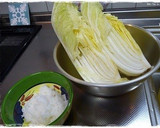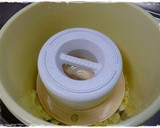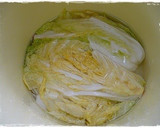Korean Kimchi from the Source

Just when I was thinking "I want to make my own authentic kimchi!" I had a chance to learn how to do so from a Korean friend. Since then, I've been experimenting and researching the method (while receiving feedback) to come up with this recipe.
The salt-preserving and draining stages for the Chinese cabbage are important!
Make sure to protect your hands with gloves when handling the red chili pepper!
The ingredient amounts are simply guidelines. They will vary depending on the size of the cabbage and how salty it is, so adjust as you go. Recipe by yonayuna
Cooking Instructions
- 1
Wash the Chinese cabbage, make cuts in the stem end and rip into half with your hands. Rip into half again to end up with 4 quarters.
- 2
Make a high concentrate salt water in a large tub or bowl, and completely immerse the Chinese cabbage in it. Leave to soak so that the salt water penetrates to the core.
- 3
When the leaves have become wilted, take the cabbage out and drain it off. Peeling back the leaves one by one, sprinkle in some salt, concentrating on the cores.
- 4
Line the salted cabbage quarters in a pickling tub, add a weight and leave to pickle for 1/2 to 1 whole day or so. Turn it over occasionally so that it cures evenly.
- 5
When the salt-pickled cabbage is done, rinse it well under running water. It should taste a bit salty.
- 6
Put the cabbage on a sieve or colander and leave to drain and dry for 3 to 4 hours.
- 7
When the salted cabbage is done, make the yangnyeom (kimchi base). Prepare each ingredient.
- 8
Cut the daikon radish into 3 to 4 mm wide sticks. Cut the green onion into 4 cm long pieces. Grate the ginger, garlic, onion and apple.
- 9
In Step 8, chop up the ginger and garlic and then purée it in the food processor.
- 10
Put the rice and water in a food processor, and process until it forms a gluey paste. Adjust the amount of water depending on the consistency of the rice.
- 11
From this point on, be sure to work with rubber gloves!! Ideally use ones that have long sleeves. Otherwise, regular rubber gloves are fine.
- 12
Put all the ingredients in a bowl (leave out the salted cabbage out) and mix together well with your hands.
- 13
When it looks like this it's all good (This is the yangnyeom.)
- 14
Peel off the dried salted Chinese cabbage leaves, and spread each one with a little yangnyeom. Take special care to put plenty of yangnyeom on the cores.
- 15
Wrap the cabbage leaves around each other with the core in the center, and it's done! Put into a sealed ziplock bag or similar, and put the bag into a sealed container and store in the refrigerator. Take out however much you'd like to enjoy each time.
- 16
If you want to easily make a small amount, mix salted and dried Chinese cabbage that's been cut up into easy to eat pieces with yangnyeom. This is even easier.
Reactions
Cooksnaps
Did you make this recipe? Share a picture of your creation!
Written by
Similar Recipes

Kimchi Burger with Korean Seaweed Sauce


Chikuwa and Cheese in Kimchi-Mayonnaise Sauce


This Goes So Well With Beer! No-Sauce Needed Kimchi Gyoza Dumplings


Korean Kimchi


Korean Kimchi


Authentic Kimchi


Easy Kimchi


Flavour of Korea: Simple Homemade Kimchi


Our Homemade Authentic Kimchi


Homemade Kimchi


Korean-Style Cucumber Kimchi


Kimchi


Công thức kimchi đơn giản của mình


Homemade Kimchi


Kimchi

กิมจิ (โฮมเมด) Homemade Kimchi ทำทานเองแบบง่าย ๆ


Easy Daikon Radish Kimchi


Easy Daikon Radish Kimchi Stock


My Kind of Kimchi


Authentic Easy Kimchi (shellfish-free)


Homemade Radish Kimchi


Kimchi 🇰🇷


Storeable Homemade Cabbage Kimchi


Vegan Kimchi


How To Make Vegan Kimchi


Cucumber Kimchi


Shiso Seed Kimchi


Kkakdugi (Cubed Radish Kimchi)


Easy Kimchi Soup


Cucumber Kimchi














Comments